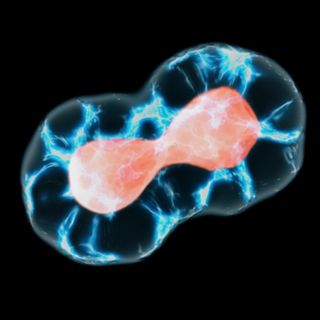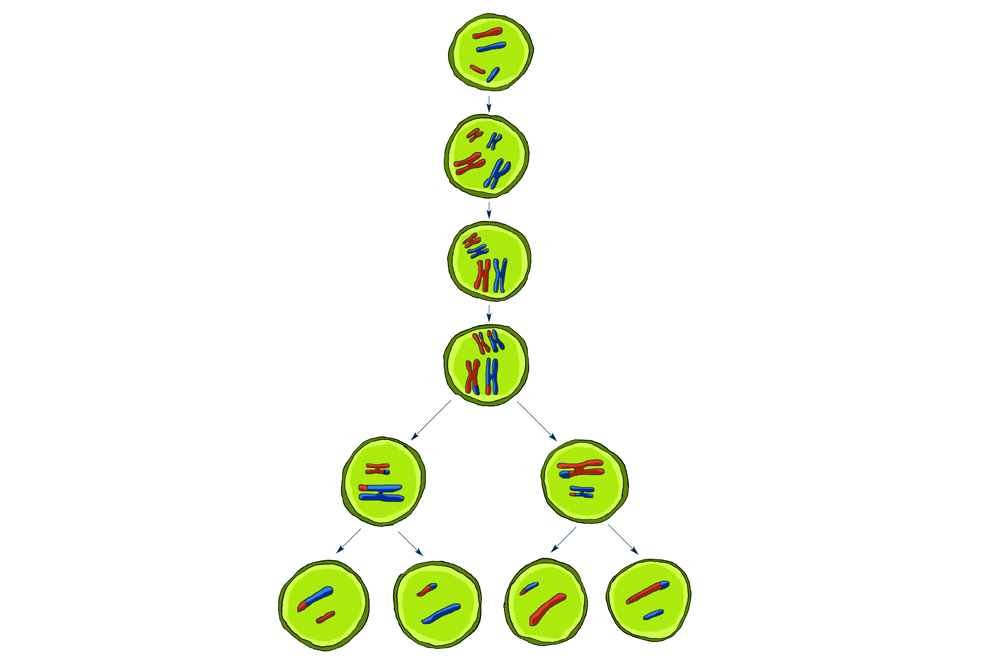Which Of The Following Statements Describes The Chromosomal Makeup Of Each Daughter Cell
What Is Meiosis?

All cells ascend from other cells through the process of cell division. Meiosis is a specialized form of prison cell division that produces reproductive cells, such as plant and fungal spores and sperm and egg cells.
In general, this process involves a "parent" cell splitting into 2 or more "daughter" cells. In this way, the parent jail cell can laissez passer on its genetic fabric from generation to generation.
Eukaryotic cells and their chromosomes
Based on the relative complexity of their cells, all living organisms are broadly classified as either prokaryotes or eukaryotes. Prokaryotes, such as leaner, consist of a single cell with a unproblematic internal structure. Their Dna floats freely inside the prison cell in a twisted, thread-like mass called the nucleoid.
Animals, plants and fungi are all eukaryotes. Eukaryotic cells have specialized components called organelles, such as mitochondria, chloroplasts and the endoplasmic reticulum. Each of these performs a specific function. Unlike prokaryotes, eukaryotic DNA is packed within a fundamental compartment called the nucleus.
Within the eukaryotic nucleus, long double-helical strands of Dna are wrapped tightly effectually proteins called histones. This forms a rod-like construction called the chromosome.
Cells in the human body have 23 pairs of chromosomes, or 46 in total. This includes two sex chromosomes: two X chromosomes for females and one X and i Y chromosome for males. Because each chromosome has a pair, these cells are called "diploid" cells.
On the other hand, man sperm and egg cells take only 23 chromosomes, or one-half the chromosomes of a diploid cell. Thus, they are called "haploid" cells.
When the sperm and egg combine during fertilization, the total chromosome number is restored. That'southward because sexually reproducing organisms receive a set of chromosomes from each parent: a maternal and paternal gear up. Each chromosome has a corresponding pair, orhomolog.
Mitosis vs. meiosis
Eukaryotes (opens in new tab) are capable of two types of cell division: mitosis and meiosis
Mitosis allows for cells to produce identical copies of themselves, which ways the genetic material is duplicated from parent to daughter cells. Mitosis produces ii girl cells from one parent prison cell.
Unmarried-celled eukaryotes, such as amoeba and yeast, utilise mitosis to reproduce asexuallyand increment their population. Multicellular eukaryotes, like humans, utilize mitosis to grow or heal injured tissues.
Meiosis, on the other hand, is a specialized grade of cell division that occurs in organisms that reproduce sexually. As mentioned above, it produces reproductive cells, such as sperm cells, egg cells, and spores in plants and fungi.
In humans, special cells called germ cells undergo meiosis and ultimately give ascension to sperm or eggs. Germ cells contain a consummate set of 46 chromosomes (23 maternal chromosomes and 23 paternal chromosomes). Past the stop of meiosis, the resulting reproductive cells, or gametes (opens in new tab), each have 23 genetically unique chromosomes.
The overall procedure of meiosis produces four girl cells from one single parent prison cell. Each daughter cell is haploid, considering it has half the number of chromosomes every bit the original parent prison cell.
"Meiosis is reductional," said M. Andrew Hoyt, a biologist and professor at Johns Hopkins University.
Unlike in mitosis, the daughter cells produced during meiosis are genetically diverse. Homologous chromosomes exchange $.25 of Deoxyribonucleic acid to create genetically unique, hybrid chromosomes destined for each girl cell.
A closer look at meiosis
Before meiosis begins, some important changes have place within the parent cells. First, each chromosome creates a copy of itself. These duplicated chromosomes are known as sister chromatids. They are fused together and the point where they are joined is known as the centromere. Fused sister chromatids roughly resemble the shape of the letter "X."
Meiosis occurs over the grade of two rounds of nuclear divisions, called meiosis I and meiosis II, co-ordinate to Nature Education's Scitable (opens in new tab). Furthermore, meiosis I and II are each divided into four major stages: prophase, metaphase, anaphase and telophase.
Meiosis I is responsible for creating genetically unique chromosomes. Sister chromatids pair upward with their homologs and exchange genetic material with one another. At the cease of this sectionalisation, one parent jail cell produces 2 daughter cells, each carrying one set of sis chromatids.
Meiosis II closely resembles mitosis. The two daughter cells move into this phase without any further chromosome duplication. The sister chromatids are pulled apart during this sectionalisation. A total of four haploid daughter cells are produced during the course of meiosis II.

Meiosis I
The four stages of meiosis Iare as follows, according to "Molecular Biological science of the Cell." (Garland Science, 2002):
Prophase I: At this phase, chromosomes become compact, dense structures and are easily visible under the microscope. The homologous chromosomes pair together. The 2 sets of sister chromatids resemble two Ten'south lined up next to each other. Each set exchanges $.25 of DNA with the other and recombines, thus creating genetic variation. This process is known as crossing over, or recombination.
Fifty-fifty though in humans the male sexual practice chromosomes (X and Y) are not exact homologs, they tin can withal pair together and exchange Dna. Crossing over occurs inside only a modest region of the two chromosomes.
By the end of prophase I, the nuclear membrane breaks down.
Metaphase I: The meiotic spindle, a network of protein filaments, emerges from two structures chosen the centrioles, positioned at either end of the jail cell. The meiotic spindle latches onto the fused sister chromatids. Past the cease of metaphase I, all the fused sis chromatids are tethered at their centromeres and line upward in the middle of the cell. The homologs yet await like ii X's sitting shut together.
Anaphase I: The spindle fibers start to contract, pulling the fused sis chromatids with them. Each X-shaped complex moves away from the other, toward opposite ends of the jail cell.
Telophase I: The fused sister chromatids reach either finish of the cell, and the cell body splits into two.
Meiosis I results in ii daughter cells, each of which contains a set of fused sister chromatids. The genetic makeup of each daughter cell is singled-out considering of the DNA exchange between homologs during the crossing-over procedure.
Meiosis II
"Meiosis II looks like mitosis," Hoyt told Live Science. "Information technology'southward an equational division."
In other words, by the finish of the process, the chromosome number is unchanged betwixt the cells that enter meiosis II and the resulting daughter cells.
The 4 stages of meiosis Two are as follows, according to "Molecular Biology of the Cell, 4th edition."
Prophase II: The nuclear membrane disintegrates, and meiotic spindles begin to form once more.
Metaphase II: The meiotic spindles latch onto the centromere of the sister chromatids, and they all line up at the center of the cell.
Anaphase II: The spindle fibers kickoff to contract and pull the sister chromatids apart. Each private chromosome now begins to moves to either end of the prison cell.
Telophase II: The chromosomes reach opposite ends of the cell. The nuclear membrane forms again, and the cell body splits into ii
Meiosis II results in four haploid daughter cells, each with the same number of chromosomes. However, each chromosome is unique and contains a mix of genetic information from the maternal and paternal chromosomes in the original parent cell.
Why is meiosis important?
Proper "chromosomal segregation," or the separation of sis chromatids during meiosis I and Ii is essential for generating healthy sperm and egg cells, and by extension, healthy embryos. If chromosomes fail to segregate completely, it'southward called nondisjunction and can effect in the formation of gametes that take missing or extra chromosomes, according to "Molecular Biology of the Cell, 4th edition."
When gametes with abnormal chromosome numbers fertilize, virtually of the resulting embryos don't survive. However, not all chromosomal abnormalities are fatal to the embryo. For example, Down syndrome occurs as a result of having an extra copy of chromosome 21. And, people with Klinefelter syndrome are genetically male but have an extra X chromosome.
The most significant impact of meiosis is that it generates genetic multifariousness, and that's a major advantage for species survival.
"Shuffling the genetic information allows you to observe new combinations which will maybe be more fit in the real globe," Hoyt said.
Which Of The Following Statements Describes The Chromosomal Makeup Of Each Daughter Cell,
Source: https://www.livescience.com/52489-meiosis.html
Posted by: bauerwone1985.blogspot.com


0 Response to "Which Of The Following Statements Describes The Chromosomal Makeup Of Each Daughter Cell"
Post a Comment